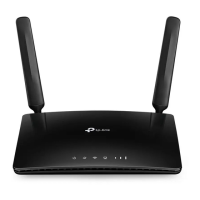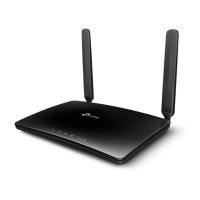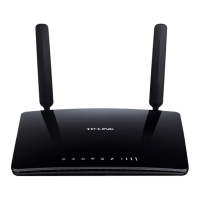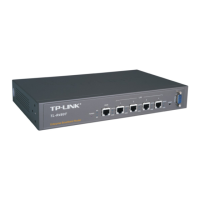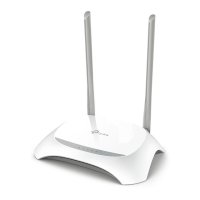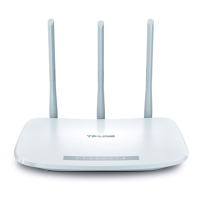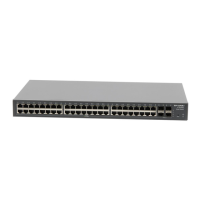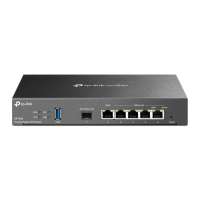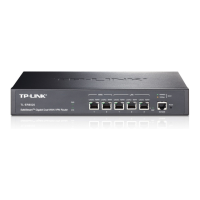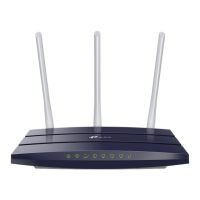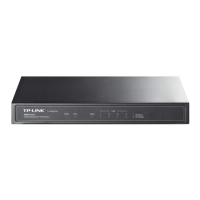Do you have a question about the TP-Link TL-MR105 and is the answer not in the manual?
Overview of the 4G LTE Router's capabilities and connectivity.
Details the physical layout of the router's front, back, and bottom panels, including ports and indicators.
Guidelines for placing the router for optimal performance and security.
Step-by-step instructions for inserting the SIM card and connecting power for initial setup.
Instructions for installing and enabling external antennas to boost LTE signal strength.
Steps to access the router's web interface and set an initial password for configuration.
Step-by-step guide for initial internet connection setup using the router's wizard.
Instructions for manually creating an internet connection profile if auto-detection fails.
How to use the router's diagnostic tool to test internet connection status.
Guide on configuring the router to operate as a standard wireless router using an Ethernet WAN connection.
Steps to register for a TP-Link ID for accessing cloud-based router management features.
How to update the email address and password associated with your TP-Link ID account.
Explanation of admin and user roles for managing router access via linked TP-Link IDs.
Guide on using the TP-Link Tether mobile app for router management.
How to enable and configure the SPI Firewall for network protection against threats.
How to block specific services or internet access for unauthorized users.
How to block or allow specific devices on the network using MAC address filtering.
How to bind IP and MAC addresses to prevent ARP spoofing and related network attacks.
How to set up and manage parental controls for internet access and website restrictions.
Steps to define effective time periods and specify website keywords for content filtering.
How to access and read SMS messages received by the router.
Instructions for composing and sending SMS messages from the router.
How to view messages that have been sent from the router.
How to access and manage unsent SMS messages saved as drafts.
Configuration options for SMS settings, including the Message Center number.
Steps to set up a separate, isolated Wi-Fi network for guests.
Options to control guest network access to local resources and among guests.
Explanation of Application Layer Gateway (ALG) for protocol traversal and NAT support.
How to set up Virtual Servers to make local services accessible from the internet.
How to use Port Triggering to dynamically open external ports for specific applications.
How to configure DMZ to expose a PC to the internet for unrestricted communication.
How to enable UPnP for seamless online gaming and other applications requiring port forwarding.
How to upgrade ISP information if the router fails to detect it automatically.
How to manage SIM card PIN settings, including locking and unlocking.
How to monitor data usage, set limits, and configure usage alerts.
Configuration options for the router's Local Area Network (LAN) settings.
Configuration options for the router's wireless network settings.
How to set up a DDNS account for remote access to the router using a domain name.
How to configure static routes for specific network paths and routing tables.
How to enable IPv6 tunneling for transitional networking environments.
How to use USSD codes to communicate with the service provider for certain queries.
How to set the router's system time manually or automatically via NTP servers.
How to turn router LEDs on/off and configure Night Mode for reduced light emission.
Information on updating the router's firmware for new features, security patches, and bug fixes.
How to back up, restore, or reset router configuration settings to prevent data loss or revert changes.
How to reboot the router manually or schedule automatic reboots for performance enhancement.
How to change the login password for the router's web management page for enhanced security.
How to control which devices on the local network can manage the router.
How to enable remote access for managing the router from the internet.
How to use ICMP Ping to diagnose network connectivity and troubleshoot issues.
How to view, save, and analyze system logs for troubleshooting and support purposes.
How to configure CWMP (TR-069) settings for automated device management by an ACS server.
Steps to resolve common issues preventing access to the router's web interface.
Steps to diagnose and fix problems preventing the router from accessing the internet.
Steps to identify and resolve issues causing slow internet performance.
Steps to resolve issues finding or connecting to the wireless network.
| Product type | Tabletop router |
|---|---|
| Product color | White |
| DSL WAN | - |
| Ethernet WAN | Yes |
| WAN connection type | RJ-45 |
| Wi-Fi band | Single-band (2.4 GHz) |
| Wi-Fi standards | 802.11b, 802.11g, Wi-Fi 4 (802.11n) |
| Top Wi-Fi standard | Wi-Fi 4 (802.11n) |
| WLAN data transfer rate (max) | 300 Mbit/s |
| Ethernet LAN data rates | 10, 100 Mbit/s |
| Ethernet LAN interface type | Fast Ethernet |
| Number of guest networks (2.4 GHz) | 1 |
| Cables included | LAN (RJ-45) |
| 4G standard | LTE-TDD & LTE-FDD |
| 3G standards | DC-HSPA+, HSDPA, HSPA, UMTS |
| SIM card type | NanoSIM |
| 4G bands supported | 800, 850, 900, 1800, 2100, 2300, 2500, 2600 MHz |
| Mobile network generation | 4G |
| Power source type | DC |
| Sustainability certificates | CE, RoHS |
| Operating temperature (T-T) | 0 - 40 °C |
| Storage relative humidity (H-H) | 5 - 90 % |
| Operating relative humidity (H-H) | 10 - 90 % |
| Firewall security | IPv4 SPI Firewall |
| Security algorithms | 64-bit WEP, 128-bit WEP, WPA, WPA-PSK, WPA2, WPA2-PSK |
| Package type | Box |
| USB port | No |
| Ethernet LAN (RJ-45) ports | 2 |
| Depth | 130 mm |
|---|---|
| Width | 174 mm |
| Height | 60 mm |
